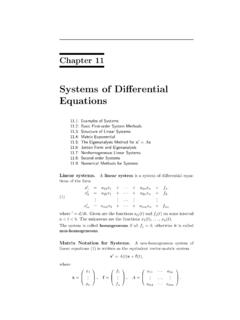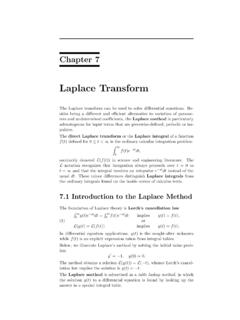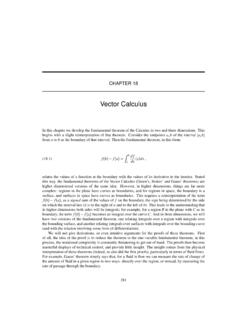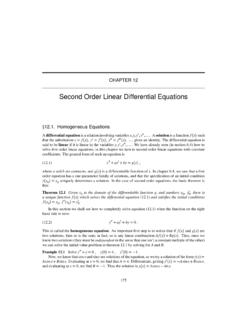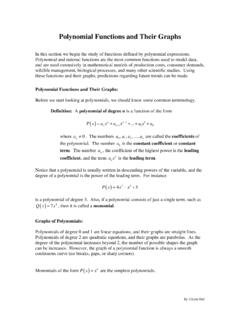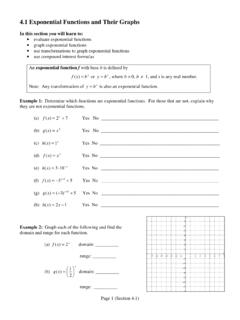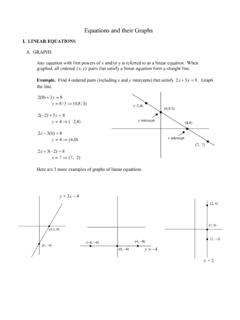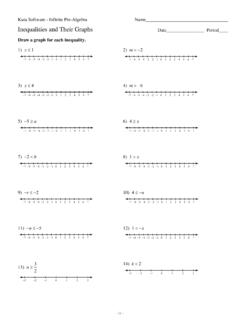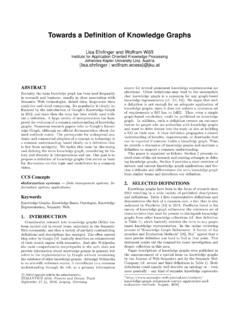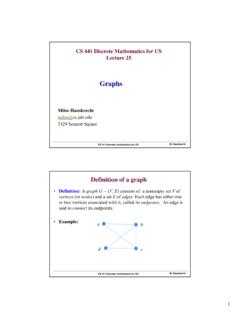Transcription of Section 2.1, Frequency Distributions and Their Graphs
1 Section , Frequency Distributions and Their GraphsThe main characteristics we will use to describe a data set are its center, its variability, and itsshape. One way to see patterns in data is to make a graph . In this Section , we will look at 3 waysto graphically summarize data: Frequency Distributions , Frequency histograms, and a cumulativefrequency Frequency distributionAfrequency distributionis a table that shows classes or intervals of data entries with a countof the number of entries in each class. Thefrequencyfof a class is the number of data entries inthe class. Each class will have a lower class limit and an upper class limit which are the lowestand highest numbers in each class. The class width is the distance between the lower limits ofconsecutive classes. Therangeis the difference between the maximum and minimum data for constructing a Frequency distribution from a data set1.
2 If the number of classes is not given, decide on a number of classes to use. This number shouldbe between 5 and Find the class width: Determine the range of the data and divide this by the number of up to the next convenient number (if it s a whole number, also round up to the nextwhole number).3. Find the class limits: You can use the minimum data entry as the lower limit of the firstclass. To get the lower limit of the next class, add the class width. Continue until you reachthe last class. Then find the upper limits of each class (since the classes cannot overlap, andoccasionally your data will include decimal numbers, remember that it s fine for the upperlimits to be decimals).4. Count the number of data entries for each class, and record the number in the row of the tablefor that class. (The book recommends using tally marks to count)ExampleMake a Frequency distribution for the following data, using 5 classes:510719251215768171722217724565 The smallest number is 5, and the largest is 25, so the range is 20.
3 The class width will be 20/5 = 4,but we need to round up, so we will use 5. Our classes will be 5 9, 10 14, 15 19, 20 24, and 25 , counting the number of entries in each class, we get:ClassFrequency5 91010 14215 19420 24325 291 Note that the sum of the frequencies is 20, which is the same as number of data entries that we can add more information to your Frequency distribution table. The midpoint (or classmark ) of each class can be calculated as:Midpoint =Lower class limit + Upper class relative Frequency of each class is the proportion of the data that falls in that class. It canbe calculated for a data set of sizenby:Relative Frequency =Class frequencySample size= cumulative Frequency is the sum of the frequencies of that class and all previous the midpoint of each class, the relative Frequency , and the cumulative Frequency to previousfrequency frequencyCumulative frequency5 Frequency histogramAfrequency histogramis a graphical way to summarize a Frequency distribution.
4 It is a bargraph with the following properties:1. The horizontal scale is quantitative and measures the data The vertical scale measures the frequencies of the Consecutive bars must touch. As a result, the class boundaries are the numbers that separateclasses without forming gaps. They will be the lower limits of classes as calculated for afrequency a Frequency histogram for the data considered in class3 Cumulative Frequency graphAcumulative Frequency graph , orogiveis a line graph displaying the cumulative Frequency ofeach class at its upper class boundary. The upper boundaries are marked on the horizontal axis,and the cumulative frequencies are marked on the vertical axis. The graph should start at (or justbefore) the lower boundary of the first class (where the cumulative Frequency is zero), and end atthe upper boundary of the last class. The graph should be increasing from left to right, and thepoints should be evenly spaced along the horizontal an ogive for the data considered in class2
